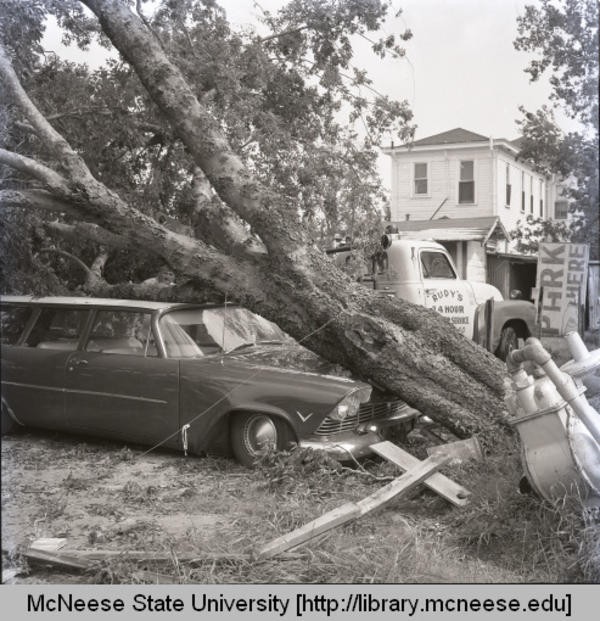Hurricane Audrey
Hurricane Audrey, the first named storm of the 1957 season, took residents by surprise with an earlier-than-expected landfall and claimed more than four hundred lives.

FRAZAR MEMORIAL LIBRARY, MCNEESE STATE UNIVERSITY
Hurricane Audrey damage.
On Thursday morning, June 27, 1957, the first named storm of the 1957 season, Hurricane Audrey, churned rapidly toward the west coast of Louisiana. With gales roughly two hundred miles from its center, the storm shocked state residents who had not expected it to strike until later that night. While over fifty thousand Louisianans had evacuated coastal areas, on and offshore oil sites, the Lake Charles Air Force Base, and even the Boy Scouts’s Camp Edgewood near Dequincy, it was not enough. Many coastal-area residents did not make it out in time, bearing the wrath of the strongest June storm in US history.
By Friday morning, it was clear that Audrey, the first major hurricane to form in the Gulf of Mexico since the 1947 and 1948 Labor Day Storms, had decimated the southwestern part of the state. Following an atypically northwestward track, the storm made landfall in Cameron Parish just over the Texas-Louisiana border, leaving much of southwest Louisiana on the storm’s eastern “dirty side,” or the side with the strongest winds and rain. Due to these factors, Louisiana suffered the largest mortality and damage rates of all affected states from of the storm. The storm’s right quadrant stretched between the state line to Lafayette, socking Lake Charles head-on and snapping homes like matchsticks, according to residents in the area. Meanwhile, a dozen subsequent tornadoes spun havoc, including a fifteen-second twister that followed the wind gusts on US Highway 90 to a mill at Michaud, ripping the roof off the plant and upending several automobiles in the parking lot.
The heaviest damage, however, was felt in coastal areas where a twenty-foot storm surge followed the hurricane. The surge devastated Cameron, Pecan Island, Creole, Black Bayou, Grand Cheniere, and Holly Beach. Scenes of damage to these areas on the following day showed residents atop splintered houses, stranded on farm roads, and huddled in refugee centers, having already been evacuated by boat or helicopter. As death tolls continued to climb over the next few days, residents mourned those who may never be found, many of whom were swept away by the high tides. In addition to the loss of human life in the coastal towns, the loss of animal life was profound. Known colloquially as the Cajun Prairie due to its ample grasses and flat landscape, southwest Louisiana had long served as the cattle headquarters for the state. Because farmers had little time to evacuate ahead of the storm and its extreme storm surge, bodies of dead horses, cattle, and wild animals littered the region. In an area near Pecan Island, a herd of 30,000 Brahman-bred cattle worth millions were washed away.
As Hurricane Audrey dissipated over northern states, its final death toll stood at more than four hundred, with damages reaching $150 million, the equivalent of $1.38 billion in 2022.
